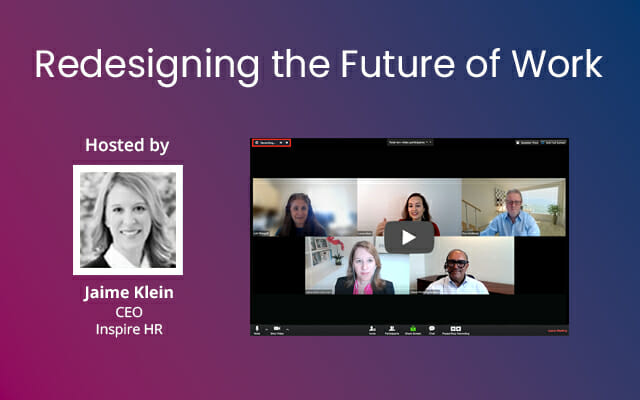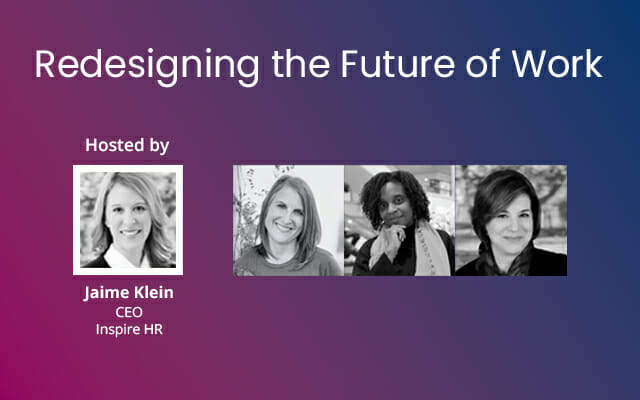
Setting Realistic Expectations: Stability for the Employee + the Company
SEP 16, 2020
Setting Realistic Expectations: Stability for the Employee + the Company
As fall sets in and schools incrementally re-open, we are hearing a common challenge among HR and business leaders: how to set realistic employee expectations while offering the flexibility that team members need. Companies are wondering how to balance organizational needs with their commitment to a human-centric approach to their people.
Salesforce recently grabbed headlines when they announced they were offering an additional six weeks of paid leave to parents. Earlier this year, Twitter decided to keep its workforce permanently remote, and Facebook, Google, Square, and others across all industries keep extending their work from home timelines. Meanwhile, Netflix Co-CEO Reed Hastings just this month referred to remote work as “a pure negative,” citing the loss of brainstorming sessions as the biggest challenge to a remote environment.
The solution is not as simple as generous remote working policies, stipends for office furniture, or subscriptions to wellness apps. Every company has different needs, and a one-size-fits-all approach just doesn’t work—for the company or the employee.
What leaders and employees both need most right now is a sense of stability. Getting there involves meeting employees where they are and shifting away from temporary quick-fixes to culture-enhancing employee relations policies.
Meet your employees where they are
The HR and parenting worlds were abuzz this summer following the publications of Deb Perelman’s op-ed in The New York Times: “In the COVID-19 economy, you can have a kid or a job. You can’t have both.” As Perelman describes, flexible working schedules are helpful, but sacrificing sleep for pre-dawn and midnight working sessions does not provide any kind of balance. Flexibility is not enough if it does not go hand-in-hand with realistic expectations.
Clear communication is critical. Employees and managers need open conversations where both are willing to share their challenges so they can devise realistic solutions together.
At Inspire, we have seen something as simple as shifting a staff meeting time to avoid conflicting with a child’s recurring Zoom school meeting reduce tremendous stress for an employee. We’re also stressing the importance of flexible schedules so employees can better manage all that needs to get done on the homefront. These are manageable conflicts, but only when they come to light—only when employees feel comfortable to share their needs with leaders.
And parents are not the only ones struggling right now. The Kaiser Family Foundation reports more than half of Americans feel the pandemic is negatively impacting their mental health—a number that jumps to 68% among Black Americans. Every human has more on their plate now than they did in February. Many are dealing with the economic hardship of the loss of an income within their household. The renewed focus on racial injustice has placed additional burdens for guidance and leadership on our Black colleagues, people are finding it extra difficult to care for an aging parent or relative, and dozens of other stressors affect each of us daily.
Now is the time to lead with heart. Listen to what your employees are saying—and not saying—and be willing to meet them where they are.
Shift from band-aid fixes to formalized policies
In March, no business was ready for months of lockdown and extended periods of social distancing. Still, I was incredibly impressed by the humanity and authenticity so many businesses were showing to their teams. But whether it was flexible schedules for working parents, weekly social hours on Zoom, daily leadership check-ins, reduced hours for caregivers, or other accommodations, these were all band-aid fixes to a problem that required immediate attention.
Now is the time to look at the immediate solutions you introduced in the spring and evaluate which should stay, which should go, and which gaps still need to be addressed.
The pandemic is not going away anytime soon, and even when it does, the impact of remote working, the accelerating pace of digitalization, and the appreciation for truly inclusive cultures are here to stay.
Look at each phase of the employee experience, from recruitment and onboarding to performance evaluations, professional development, and ultimately offboarding to evaluate how each phase aligns with the future of work. Employees may benefit from more frequent check-ins, require more direct mentorship as face-to-face meeting time has diminished, or need more senior-level sponsorship for initiatives they are championing.
Companies that may have been able to rely on flexible scheduling throughout the spring and summer should consider if interim help might relieve burdens on their overly stretched workforce. Or, if performance reviews had formerly existed as annual moments-in-time, create more of an on-going process and dialogue—and build it into company policies and culture. Now is the time to move from band-aid fixes to more stable solutions.
Lead with heart
Setting realistic employee expectations allows for results and understanding. Flexibility does not mean hands-off management. On the contrary, the most agile and flexible companies are actively removing barriers for their employees so the team as a whole can perform at its best.







